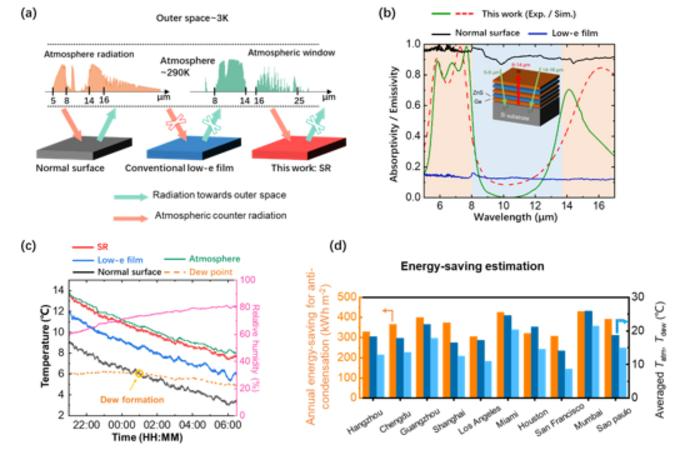At night, direct heat loss to space through the atmospheric transparent window (8-14 μm) can lead to temperatures plunging below freezing, posing considerable risks to agriculture (crops), outdoor cables used in transportation, and other crucial sectors.

(a) Schematic diagram of the radiative heat exchange among the atmosphere, the outer space, and the surfaces. (b) Measured absorptivity / emissivity. (c) Real-time temperature in thermal test. (d) Calculated annual energy-saving for anti-condensation of 10 cities in various climate zones. Image Credit: Yining Zhu, Yiwei Zhou, Bing Qin, Rui Qin, Min Qiu, and Qiang Li
In the past, night-time warming was typically been achieved through the use of active electric heaters, but this approach has drawbacks, including substantial energy consumption and elevated carbon emissions. The implementation of passive warming methods, such as insulating blankets (which minimize heat conduction) and low-emissivity films (which decrease heat radiation), have been explored. However, these methods have limitations, including suboptimal effectiveness and an overall positive net heat loss.
Air can maintain relatively higher temperatures compared to the ground during the night as it is known for its high heat capacity for serving as an external heat source. Radiative methods are required to harness energy from the entire atmosphere above the Earth's surface.
A team of researchers, led by Professor Qiang Li from Zhejiang University, China, suggested a night-time radiative warming strategy based on nanophotonic control in a study published in Light Science & Application. This strategy inactively suppresses the thermal radiation of objects in the atmospheric transparent window (8-14 μm) while actively utilizing energy in the atmospheric radiation bands (5-8 μm and 14-16 μm).
This strategy involves applying a selective reflective (SR) thin film over the target surface. This film needs to have high reflectance within the atmospheric transparent band and high absorptivity within the atmospheric radiation bands. Doing so controls the flow of radiative energy, effectively increasing the temperature of the target area.
Scientists calculated and fabricated the device using a broadband infrared-absorbing substrate combined with germanium and zinc sulfide one-dimensional photonic crystal films. The device attained a reflectance of 0.91 in the atmospheric transparent window and an absorptivity of 0.7 in the atmospheric radiative bands.
Thermal testing conducted outdoors by covering SR film increased the target's temperature by 2.1 °C/4.4 °C compared to a broadband reflective (low-e) surface and a broadband absorptive surface, respectively.
The research also evaluated how this night-time warming approach could be used in cities with varying climates. It showed that the yearly electricity savings could exceed 300 300 kWh m-2 across different climate zones.
Journal Reference
Zhu, Y., et al. (2023). Night-time radiative warming using the atmosphere. Light: Science & Application. doi/s41377-023-01315-y